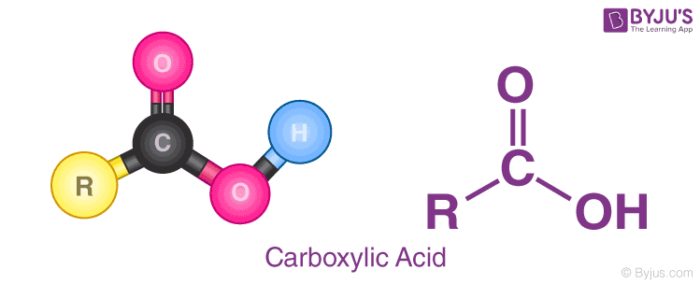what does socl2 do to a carboxylic acid
Table of Content
Definition Structure Classification Backdrop Uses
What is Carboxylic Acid?
A Carboxylic Acrid is an organic chemical compound containing a carboxyl functional group. They occur widely in nature and are likewise synthetically manufactured by humans. Upon deprotonation, carboxylic acids yield a carboxylate anion with the general formula R-COO– , which tin form a variety of useful salts such as soaps.
The carboxylic acids are the nearly important functional group that present C=O . This type of organic compounds can exist obtained by dissimilar routes, some carboxylic acids, such as citric acrid, lactic acid or fumaric acid are produced from by fermentation most of these type of carboxylic acids are practical in the nutrient industry.
Carboxylic Acid Structure
The general formula of a carboxylic acid is R-COOH , were COOH refers to the carboxyl grouping, and R refers to the balance of the molecule to which this group is attached. In this carboxyl group, there exists a carbon which shares a double bond with an oxygen atom and a unmarried bond with a hydroxyl group.
A carboxylic acid's general formula is R-COOH, where COOH denotes the carboxyl group and R denotes the remainder of the molecule to which this group is linked. In that location is a carbon in this carboxyl grouping that has a double connexion with an oxygen cantlet and a single bond with a hydroxyl group.
The offset four carboxylic acids derived from alkanes are methanoic acid (HCOOH), ethanoic acid (CH3COOH), propanoic acid (CtwoH5COOH) and butanoic acid (C3H7COOH).
The general construction of a carboxylic acrid is illustrated below.

From the illustration provided higher up, it tin be observed that a carboxylic acid contains a hydroxyl group attached to a carbonyl carbon. Due to the electronegativity of the oxygen atom, this functional group tin can undergo ionization and discharge a proton.
The carboxylate ion, produced from the removal of a proton from the carboxyl group, is stabilized by the presence of two oxygen atoms (through which the negative charge can move). Some common examples of carboxylic acids include acetic acid (a component of vinegar) and Formic acid.
The acerbity of the carboxylic acid is explained in the video.

Classification of Carboxylic Acids
Mostly, these organic compounds are referred to by their trivial names, which contain the suffix "-ic acid". An example of a trivial name for a carboxylic acid is acerb acid (CH3COOH) . In the IUPAC nomenclature of these compounds, the suffix "-oic acid" is assigned.
The guidelines that must be followed in the IUPAC classification of carboxylic acids are listed beneath.
- The suffix "e" in the name of the corresponding alkane is replaced with "oic acid".
- When the aliphatic concatenation contains but ane carboxyl grouping, the carboxylic carbon is always numbered one. For case, CHthreeCOOH is named as ethanoic acid.
- When the aliphatic chain contains more than than ane carboxyl group, the total number of carbon atoms is counted and the number of carboxyl groups is represented by Greek numeral prefixes such as "di-", "tri-", etc.
- A carboxylic acid is named by adding these prefixes and suffixes to the parent alkyl chain. Arabic numerals are used for indicating the positions of the carboxyl grouping.
- The name "carboxylic acid" or "carboxy" can also be assigned for a carboxyl substituent on a carbon chain. An example of such classification is the name 2-carboxyfuran for the chemical compound 2-Furoic acrid.
Carboxylic Acrid Examples
Some examples describing the nomenclature of carboxylic acids every bit per IUPAC guidelines are provided below.
| Trivial Name and Formula | IUPAC Proper name of the Carboxylic Acid |
| Formic acid, H-COOH | Methanoic acid |
| Crotonic acid, CHthreeCH=CH-COOH | But-ii-enoic acid |
| Carbonic acid, OH-COOH | Carbonic acid |
| Butyric acrid, CH3(CHii)twoCOOH | Butanoic acid |
Properties of Carboxylic Acids
Most of the properties of carboxylic acids are a result of the presence of the carboxyl group. Some physical and chemical properties of these compounds are discussed in this subsection.
1. Physical Properties of Carboxylic Acids
- Carboxylic acid molecules are polar due to the presence of two electronegative oxygen atoms.
- They also participate in hydrogen bonding due to the presence of the carbonyl group (C=O) and the hydroxyl grouping.
- When placed in nonpolar solvents, these compounds grade dimers via hydrogen bonding between the hydroxyl group of ane carboxylic acid and the carbonyl grouping of the other.

- The solubility of compounds containing the carboxyl functional group in water depends on the size of the compound. The smaller the chemical compound (the shorter the R group), the college the solubility.
- The boiling betoken of a carboxylic acrid is mostly higher than that of water.
- These compounds have the ability to donate protons and are therefore Bronsted-Lowry acids.
- They by and large have a stiff sour smell. Nevertheless, their esters have pleasant odours and are therefore used in perfumes.
2. Chemical Properties of Carboxylic Acids
- The α-carbon belonging to a carboxylic acid tin can easily exist halogenated via the Hell-Volhard-Zelinsky reaction.
- These compounds can be converted into amines using the Schmidt reaction.
- A carboxylic acid tin exist reduced to an booze by treating it with hydrogen to cause a hydrogenation reaction.
- Upon reaction with alcohols, these compounds yield esters.
Uses of Carboxylic Acids
- Fat acids that are essential to human beings are made up of carboxylic acids. Examples include omega-vi and omega-3 fatty acids.
- Higher fat acids are also used in the manufacture of soaps .
- The product of soft drinks and many other food products involve the use of many carboxylic acids.
- The manufacture of prophylactic involves the employ of acerb acrid as a coagulant.
- Hexanedioic acid is used in the manufacture of nylon-half-dozen,6 .
- Carboxylic acids have numerous applications in the rubber, fabric, and leather industries.
- Ethylenediaminetetraacetic acrid is a widely used chelating agent.
- The synthesis of many drugs involves the use of these compounds. Therefore, carboxylic acids are very important in pharmaceuticals .
- The production of many polymers involves the use of compounds containing the carboxyl functional grouping.
Frequently Asked Questions – FAQs
What Is carboxylic acid used for?
In the manufacture of polymers, biopolymers, coatings, adhesives, and prescription products, carboxylic acids and their derivatives are used. They tin too be used as solvents, antimicrobials, food additives, and flavourings.
What are examples of carboxylic acids?
Carboxylic acids are hydrocarbon compounds in which a carboxyl group has substituted one or more than of the hydrogen atoms in the hydrocarbon. Methanoic acid (HCOOH), ethanoic acid (CH3COOH), propanoic acid (C2H5COOH), and butanoic acid (C3H7COOH) are the first four carboxyl acids derived from alkanes.
What foods contain carboxylic acids?
In plants and animals, sure carboxylic acids exist naturally. There is citric acid in citrus fruits, such equally oranges and lemons. A large carboxylic acid with three ionizable hydrogen atoms is citric acid. It is present in citrus fruits and provides them with a sour or tart taste.
Why are carboxylic acids acidic?
The carboxylic acids are acidic because of the hydrogen in the -COOH grouping, using the thought of an acid equally a "substance that donates protons (hydrogen ions) to other things." A hydrogen ion is moved from the -COOH group onto a water molecule in a water solution.
Are carboxylic acids strong or weak?
Carboxylic acids are defined as weak acids, meaning that in a neutral aqueous solution, they do not fully dissociate to create H+cations. Hydrogen bonding betwixt carboxylic acidsHydrogen bonding betwixt carboxylic acidsCarboxylic acids bail with hydrogen themselves, giving them a greater degree of stability.
Thus, the full general formula, structure, nomenclature, properties, and uses of carboxylic acids are briefly discussed. To acquire more about these compounds and other types of organic compounds, such as aldehydes and ketones, annals with BYJU'S and download the mobile application on your smartphone.
Source: https://byjus.com/chemistry/carboxylic-acid-properties/
0 Response to "what does socl2 do to a carboxylic acid"
Postar um comentário